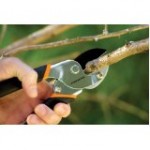 If you have a garden you are probably going to face a pruning job at some time. Some plants require constant pruning, others only need an occasion clip. Pruning is generally not a favorite gardening job but it can be made better by using the proper tools. Unfortunately, good quality tools for pruning are usually fairly expensive but they will last a long time and serve you well with proper care. See also How to Prune a Deciduous Tree or Shrub.
If you have a garden you are probably going to face a pruning job at some time. Some plants require constant pruning, others only need an occasion clip. Pruning is generally not a favorite gardening job but it can be made better by using the proper tools. Unfortunately, good quality tools for pruning are usually fairly expensive but they will last a long time and serve you well with proper care. See also How to Prune a Deciduous Tree or Shrub.
The tools you need depend on the plants you have to trim. If you have a lot of different shrubs and trees that need pruning you will probably need a variety of tools. The best strategy is to buy a selection of tools that can cut stems and branches of increasing size. It is very important that the tool match the job that it has to do. Using a tool that is too small will strain the tool and end up breaking it. Here are pruning tools starting with ones for the smallest jobs and proceeding to those for the largest job.

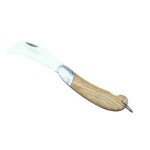 Pruning Knife:
Pruning Knife:
The curved blade identifies this tool. It allows it to keep contact with the branch or stem as you cut. If the blade folds into the handle, the knife will fit into a pocket and can be carried easily and safely every time you go into the garden and be available for small cutting jobs like slicing a stem to remove insect larvae.

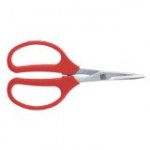 All purpose Gardening Scissors: These fine bladed, large handled scissors are perfect for light weight pruning jobs, such as deadheading, flower picking, and vegetable harvesting. The thin blades can go into places nothing else can and the large handles allow you to use them even with gloves. Good quality stainless steel scissors are a must as cheap ones will fall apart quickly.
All purpose Gardening Scissors: These fine bladed, large handled scissors are perfect for light weight pruning jobs, such as deadheading, flower picking, and vegetable harvesting. The thin blades can go into places nothing else can and the large handles allow you to use them even with gloves. Good quality stainless steel scissors are a must as cheap ones will fall apart quickly.

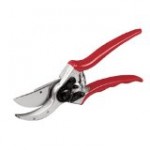 Bypass hand pruning shears: The British call them secateurs and they are the most useful pruning tool the gardener is likely to own. These are the basic tool for pruning everything under about one-half inch in diameter. It’s important to use the bypass or blade type type shears (show in the photo to the right) rather than the anvil type (shown in the photo at the top of the page). The bypass type is preferred because they make accurate, clean cuts very close to an adjacent branch and prevent tearing or crushing of tissues. Bypass shears can be purchased in both left- or right-handed types and the blades can usually be replaced. The Anvil type pruners have a sharp blade that comes down on a flat pad made of soft metal. Anvil shears frequently damage the branch at the cutting point and leave short stubs that require longer time to heal than the clean bypass cuts.
Bypass hand pruning shears: The British call them secateurs and they are the most useful pruning tool the gardener is likely to own. These are the basic tool for pruning everything under about one-half inch in diameter. It’s important to use the bypass or blade type type shears (show in the photo to the right) rather than the anvil type (shown in the photo at the top of the page). The bypass type is preferred because they make accurate, clean cuts very close to an adjacent branch and prevent tearing or crushing of tissues. Bypass shears can be purchased in both left- or right-handed types and the blades can usually be replaced. The Anvil type pruners have a sharp blade that comes down on a flat pad made of soft metal. Anvil shears frequently damage the branch at the cutting point and leave short stubs that require longer time to heal than the clean bypass cuts.

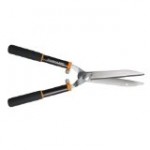 Hedge Shears: With long blades and long handles, hedge shears can quickly cut through twigs or branches less than 1/4 inch in diameter and remove a large amount of plant material in a single stroke. They are made for shearing a hedge, not pruning single branches with precision or clean cuts. In addition to straight blades, hedge shears are also made with wavy blades help keep the stems from sliding as they are cut. Electric shears are a good option if you have a very long hedge especially if it requires a flat top.
Hedge Shears: With long blades and long handles, hedge shears can quickly cut through twigs or branches less than 1/4 inch in diameter and remove a large amount of plant material in a single stroke. They are made for shearing a hedge, not pruning single branches with precision or clean cuts. In addition to straight blades, hedge shears are also made with wavy blades help keep the stems from sliding as they are cut. Electric shears are a good option if you have a very long hedge especially if it requires a flat top.

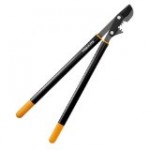 Bypass Lopping Shears: For most cuts between one-half inch to about one inch the lopping shears are the tool of choice. These come in both bypass and anvil types and just as with the hand shears the bypass loopers does a better job. The flush cuts made by the bypass type is important when using loopers because you will frequently be making cuts as close to the tree trunk or branch as possible. From years in the nursery business we have one word of advise when using looping shears. They have long handles that provide extraordinary cutting power, but its important not to get carried away with this power and attempt to cut branches larger than the tool is built to handle. Cutting over-sized branches will soon result in excessive ware or bending of the blades and the quality of cuts will be less than acceptable.
Bypass Lopping Shears: For most cuts between one-half inch to about one inch the lopping shears are the tool of choice. These come in both bypass and anvil types and just as with the hand shears the bypass loopers does a better job. The flush cuts made by the bypass type is important when using loopers because you will frequently be making cuts as close to the tree trunk or branch as possible. From years in the nursery business we have one word of advise when using looping shears. They have long handles that provide extraordinary cutting power, but its important not to get carried away with this power and attempt to cut branches larger than the tool is built to handle. Cutting over-sized branches will soon result in excessive ware or bending of the blades and the quality of cuts will be less than acceptable.

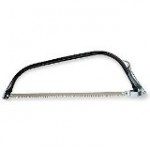 Bow Saw: For limbs between 1″ – 3″ you may need a bow saw. It quickly cuts through branches by cutting in both the push and pull movement. Because of its large size the bow saw is difficult to use in tight working conditions where there is a tangle of branches that blocks the back and forth movement of the saw. The bow saw is most useful for quickly cutting branches during the pruning clean-up.
Bow Saw: For limbs between 1″ – 3″ you may need a bow saw. It quickly cuts through branches by cutting in both the push and pull movement. Because of its large size the bow saw is difficult to use in tight working conditions where there is a tangle of branches that blocks the back and forth movement of the saw. The bow saw is most useful for quickly cutting branches during the pruning clean-up.

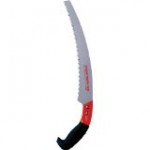 Pruning Hand Saw: The value of the hand saw cannot be over stated when pruning. It makes very close cuts that will heal quickly. For branches too large to be cut with a hand pruner or lopping shears, pruning saws are the best tool to use. Pruning saws differ greatly from traditional carpenters hand saws in the length and shape of the blade, the layout and type of teeth and their design to cut on the “pull-stroke.” They come in many sizes from from small (usually 8 – 10 inches) to large with up to about 24 – 30 inch blades. The small size comes in a fold out style (like a large pen knife) that is very handy. The saw should be used when cutting branches larger than one inch or close to the trunk of the tree or shrub.
Pruning Hand Saw: The value of the hand saw cannot be over stated when pruning. It makes very close cuts that will heal quickly. For branches too large to be cut with a hand pruner or lopping shears, pruning saws are the best tool to use. Pruning saws differ greatly from traditional carpenters hand saws in the length and shape of the blade, the layout and type of teeth and their design to cut on the “pull-stroke.” They come in many sizes from from small (usually 8 – 10 inches) to large with up to about 24 – 30 inch blades. The small size comes in a fold out style (like a large pen knife) that is very handy. The saw should be used when cutting branches larger than one inch or close to the trunk of the tree or shrub.

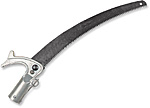 Pole Saw: The pole saw is basically a hand saw on the end of a pole. By having the long pole they are used to cut branches beyond arms reach. These saws usually have a wooden pole about 18 – 20 feet long with an 18 inch saw attached to the end. These saws are particularly good for removing small branches in mature trees. With their curved blade these saws can easily cut small branches with one pull of the handle. These saws are inexpensive and are of value if the home garden includes larger trees or a small orchard. A pruning head is sometimes an integral part of a pole saw for use in cutting small branches. These are similar to lopping shears and come in both by-pass and anvil styles. As with the lopping shears the the by-pass type is preferred. A pole saw can be an outstanding pruning tool; however, because of the danger of electrocution, pole saws should not be used near utility lines except by qualified utility line clearance professionals.
Pole Saw: The pole saw is basically a hand saw on the end of a pole. By having the long pole they are used to cut branches beyond arms reach. These saws usually have a wooden pole about 18 – 20 feet long with an 18 inch saw attached to the end. These saws are particularly good for removing small branches in mature trees. With their curved blade these saws can easily cut small branches with one pull of the handle. These saws are inexpensive and are of value if the home garden includes larger trees or a small orchard. A pruning head is sometimes an integral part of a pole saw for use in cutting small branches. These are similar to lopping shears and come in both by-pass and anvil styles. As with the lopping shears the the by-pass type is preferred. A pole saw can be an outstanding pruning tool; however, because of the danger of electrocution, pole saws should not be used near utility lines except by qualified utility line clearance professionals.

 Chain Saw: If large limbs (over 3 – 4 inches) are being cut or a tree is being removed the chain saw is the preferred tool. In most cases for the home gardener when the pruning gets to this level it’s time to hire a professional arborist to do the job.
Chain Saw: If large limbs (over 3 – 4 inches) are being cut or a tree is being removed the chain saw is the preferred tool. In most cases for the home gardener when the pruning gets to this level it’s time to hire a professional arborist to do the job.
When you select tools be aware that there are several criteria for an excellent tool. High quality materials is certainly one, effective cutting is another, but comfort is high on the list too. A tool that fits the size and shape of your hand can make all the difference in how you view pruning chores. Always handle a tool before you buy and think about how long you will be using it at one time and what kinds of jobs you will be using it for.
